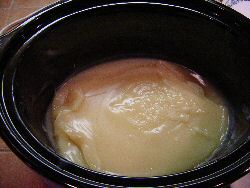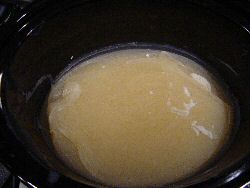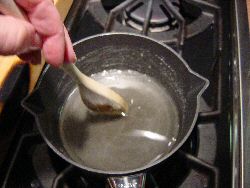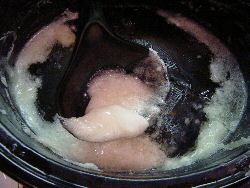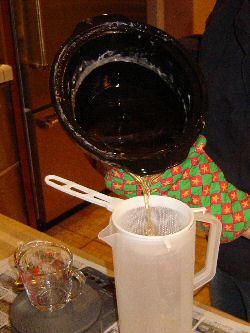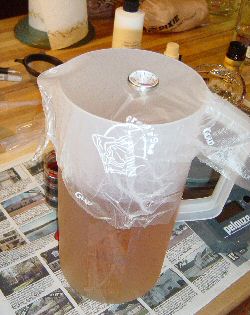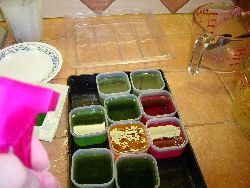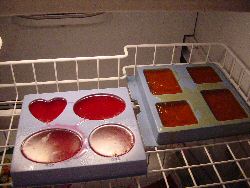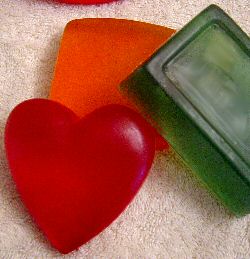Making Transparent Soap
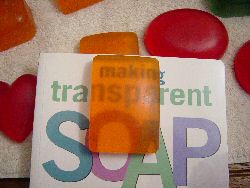
This is the result of my experiments making transparent soap. I am in no way, shape or form an expert, but I have successfully made transparent soap using recipes found on the web as well as formulating my own. I highly recommend reading the book
"Making Transparent Soap" by Catherine Failor before you begin. This tutorial is not intended to replace the book, it is intended to complement the book. Transparent soap is basically partly soap and partly solvent. Sodium Hydroxide causes crystals to form in soap and that is why the soap becomes opaque, in order to make it transparent, you have to dissolve the soap in enough solvent to make the crystals so small that the the light will freely pass through the soap, which makes it look transparent. There is no magic number when it comes to the quantity of solvents required for a particular recipe, transparency will exist in a narrow window within a range. A good way to find the right quantity of solvents is to start by calculating a 60% soap/40% solvent ratio and then a 50% soap/50% solvent ratio, depending on your formula, transparency will exist somewhere in that range. (See the
calculation page for tips on formulating your own recipes and to download a Transparent soap calculator to help you with the task.
This tutorial is intended for people who already know how to make soap and are aware of the safety precautions that should be taken in order to do so.
In this tutorial, we will use a very popular recipe by Jeff Bobeck. It is a good basic recipe and it works, it yielded my first successful batch of transparent soap, I modified it because I use 75.5% Alcohol instead of the 70% Alcohol used in the original recipe. Formulas can be adapted to use with the Alcohol you can find, although it would be difficult to go below 70% (140 Proof). Ideally, if you can find 190 Proof Alcohol, use it, it will make your life easier, if you can't, you can adapt a recipe to work with what you can find, just go to the calculation page to find out how. You need Ethanol (grain Alcohol) (Everclear) to make transparent soap, Isopropyl Alcohol will not work. I use a crock pot, I have gas appliances so I can't do it on the stove, using a slow cooker is an easy way to do it without the risk of setting the house on fire.
First,
print the recipe, assemble your supplies and clear 5 to 6 hours off your schedule. Preheat your oven to 180F (if it will go that low, if not, you will use the slow cooker to bring your soap to gel). Put a clear cup or glass in the freezer, you will need it to test the transparency of your soap. You will also need a wisk, lots of spoons, a spray bottle with alcohol in it, colorants (food colorants work, Select Shades are great), FO or your favorite perfume, a large pot with a spout, some Glad Press'n seal plastic wrap and a small plastic strainer.
Measure your oils and heat them up in the slow cooker, I use a 4 quarts slow cooker, anything smaller would not work for this recipe, if you use a larger crock pot, you may have to tip it on its side somewhat so you can use your stick blender to mix the oils and the lye solution. Mix the lye with 6 oz of water and set aside to cool. When the oils and the lye are about 140F, pour the lye solution into the oils and stir with the stick blender, it should take only a few minutes to get to a good medium trace.
At that point, put the cover on the soap and put it in a 180F oven for 1 1/2 hour. (If your oven won't go that low, just leave the soap in the slow cooker on warm and check it after an hour to see if it is going through the gel stage, I am not sure how long it will take for the soap to become neutral that way, but it should not take more than 2 hours. Try to minimize water loss because we already took a big water discount).
After 1 1/2 hour, your soap should be neutral (PH of 9 - 10.5 is fine). The entire soap mass should be in the gel stage and look like somewhat like this:
Stir it and test it either with phenolphthalein (if you have any) or litmus paper, if you don't mind the "tongue test", there should be no zap :) (To test using Litmus paper, dissolve some of the soap into a little bit of water and apply the paper to the soap, this should give you a good reading).
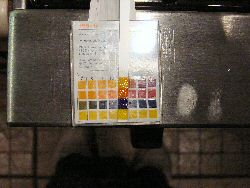
When you are certain that your soap is "neutral", it is time to mix in the Alcohol and the Glycerin. Measure 13.5 oz of Alcohol and 3 oz of Glycerin. Mix the Glycerin into the Alcohol and then, off heat, start pouring into the soap mass while stirring with a whisk. Pour the Alcohol/Glycerin mix in slowly, taking time to break up lumps of soap. You must work quickly in order to minimize the loss of Alcohol, but do not panic and go too fast, take the time to break the big lumps. Finish with the stick blender or a potato masher, anything that will break the bigger pieces. Make sure you get all the soap that sticks to the sides and the bottom of the bowl. All the soap will not dissolve completely right way, you will have pieces of soap floating in a soupy mixture of Alcohol/Glycerin and dissolved soap. That's alright, the little lumps will dissolve during the cook. Keep your head away from the bowl otherwise you will get an instantaneous hang over ;). start the kitchen fan, Alcohol vapors are highly flammable and you don't want them to accumulate in your kitchen.
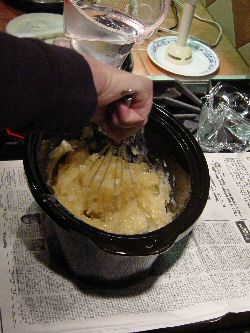
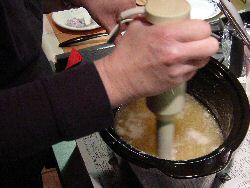
Put the cover back on the crock pot insert and put the insert back in the slow cooker. Cook on warm (depending on your slow cooker, you may have to start it on high for a few min., then put it back on warm) for 30 - 45 min. Check it once in a while, the temperature should be between 160 - 180F. I have a very cheap slow cooker that I bought at Wallmart for $15.00 and the lid does not fit very well, so I put a band of Glad Press'n Seal plastic wrap around the edge of the lid to prevent the loss of Alcohol while the soap cooks.
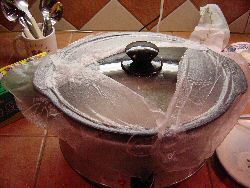
After 30 - 40 minutes of cooking time, check to see if the soap is well dissolved, there will be a layer of foamy soap on top, spray that down with some alcohol in a spray bottle. Stir with a clean spoon. Some of it won't want to go back into the solution and will float on top, do not worry, this is normal, we will address that a bit later. Prepare your sugar syrup. Heat 4 oz of water to a boil, turn off the heat, pour in 8 oz of sugar and stir until all the sugar is dissolve. Turn the heat back on and bring it back to a boil, then let simmer covered for 1 - 2 min to make sure all the sugar is well dissolved.
Pour the sugar solution into the soap and stir. Take a large soup ladle and skim the foamy soap from the top, put that in a small dish, mash it and scent it, add a little bit of glycerin to it and pour it in a mold. This time I had 2.9 oz of foamy soap, it made a nice little hand soap.
Get the cup you put in the freezer before you began the soap, and pour a little bit of the clear soap stock on it to test the transparency.
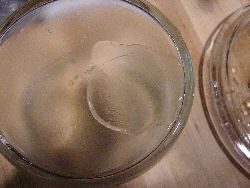
At first the soap sample may look transparent, but it may not be, put the cup in the freezer for 5 - 10 min and look at it again. If your soap looks milky, it needs more solvents. That is when making transparent soap can test your patience. Do not panic at this time and think the soap will go bad if you have to make more than one test, the soap is perfectly fine on warm setting in the crock pot, as long as you keep the mixture around 160F, you can take all night to adjust it if you want, just make sure to spritz some Alcohol on it and then put the cover on to minimize the loss of Alcohol in between tests. You may have lost some of the Alcohol during cooking time so your soap is not transparent yet. (That is what happened to me this time). We are working from an existing recipe that we know works, so the solvent requirements should be pretty close to the numbers provided. In my case, I added .5 oz of Alcohol. My soap was still not transparent enough, so I added 2 oz of sugar dissolved in 1 oz of water. Finally, I added 2 oz of glycerin, 1 oz at a time. (For a total of 14 oz of Alcohol, 10 oz of sugar in 5 oz of water and 5 oz of glycerin). I didn't have to do that the last time I made that soap, that shows that you may have to adjust recipes, even good ones, because there are a lot of factors that can influence the final results.

I finally had a clear sample, so it was time to pour the soap into a jar to let it cool down a little. I poured through a strainer, to keep any soap flecks or foam out of the final soap stock.
Cover the jar with some Press'n Seal and insert a thermometer, let the soap cool to about 140F before you add the colors and the fragrance.
When your soap has cooled off to 140F, scent and color it, then pour it into molds. (There will be a skin on top of the soap, spritz it with a little alcohol and then mix it, it should dissolve). You may have some foam on top of the soap after you pour it in the molds, a good spritz of Alcohol should take care of it. (Note: I pour my soap in my molds through a small strainer, just to make sure)
If you can, put the molds in the freezer, the faster the cool off, the more transparent the soap, if you do not have enough space in the freezer, put the molds in the fridge.
After a few hours, check the soap, if it is hard enough, you can unmold it, take it out of the freezer and wait about 5 min. before you pop the soap out of the mold. Be careful not to touch it too much, because at this point, you will leave fingerprints on it. Let the soap dry and cure for about 2 weeks before you use it, during those two weeks, it will become harder and even more transparent. A skin will form on top of the soap, polish it with alcohol and then wrap in shrink wrap to keep the humidity out.
Note: Home made transparent soap is different from M&P, if you try to melt it again, it will loose its transparency, you will have to adjust the solvents and you may end up with a soft sticky soap. If you absolutely have to remelt the soap, do it as soon as possible after making it, but be prepared to add alcohol, glycerin and sugar solution again.


